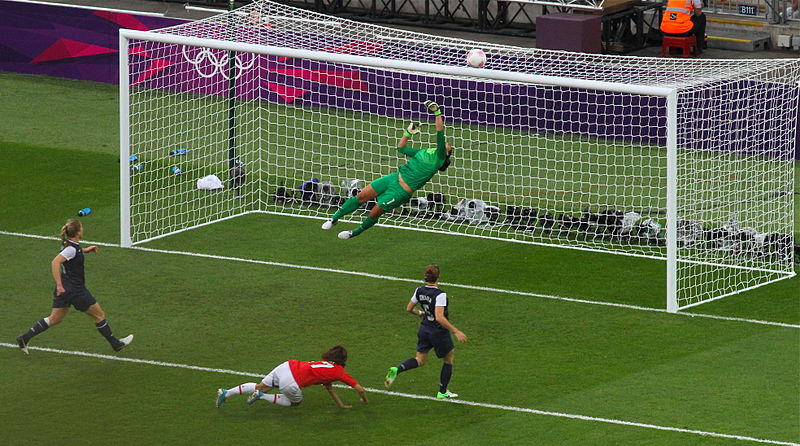When Thailand lost 13-0 to the United States in the FIFA Women’s World Cup in 2019, it sparked global debates about whether goalpost and pitch sizes should be reduced in the women’s game.
Emma Hayes, the hugely respected and admired manager of Chelsea Women, caused great controversy when she claimed that it could greatly benefit the women’s game to do this. Nearly two years later the debate lives on and there remains a divide as to whether this would be empowering or insulting to women.
A smaller basketball is used in the women’s game, a shorter net is used in women’s volleyball, women’s hurdles in the Olympics are nine inches shorter than those of the men’s. The list goes on as sport increasingly compensates for the size differences between men and women.
So why does football not do this? The goalpost dimensions in football are eight-foot-high and 24-foot-wide, and are the same for both the men’s and women’s game. But from a purely logical perspective this doesn’t make any sense. The average height of a man in the UK is 5ft 9in, whereas it’s 5ft 3in for a woman. So defending a goal which has been specifically designed for those considerably taller and broader than most women seems not only unfair, but near impossible.

This is simply what women were handed, but it doesn’t necessarily mean it’s what they need to progress. In fact, the rapidly improving quality of the women’s game may shine a light on the increasing need for goal dimensions to be reconsidered if women are unable to defend the top corners of their respective goals.
The average number of goals in the Premier League has remained constant since its inception in 1992 - its first season saw 2.65 goals per game compared to 2.66 in this current campaign. However, the Women’s Super League has seen a gradual increase in goals per game, from 2.54 in its inaugural year in 2011 to 3.44 this season. The rising figure, undoubtedly linked to an improvement in standards, has led some to believe there is a need for measurements to be re-adjusted for the women’s game to remain fair.
Any views advocating the change of goal size are met with accusations of sexism, but there is a valid counter-argument; to passively accept the measurements originally designed for the men’s game is a form of sexism in itself. If emotion is cast aside, and sheer logic pursued, then changing goalpost sizes may enhance the women’s game.
But not everyone sees it this way. Many female footballers argue it is inherently sexist to assume concessions need to be made in their game, and to even suggest it implicitly insults their current standard of play. Georgia Stevens, Coventry United LFC striker and BA (Hons) Multimedia Sports Journalism student at UCFB, believes this is a precisely why both pitches and goalposts should remain as they are.
She explained: “I think it would be massively insulting to suggest that women need some sort of helping hand to be equal to the men’s game. I do think it’s sexist to assume that women need this assistance and until I see the majority of those who play the game actually calling for these measures and not the media or men who aren’t involved, then I think it will not be taken seriously.”

To imply that there is a weakness in the women’s game that needs to be compensated for is fundamentally wrong, Georgia argues. Rather than expressing concern over the size of equipment, we should divert our attention to improving the standard of the women’s game that would make such discussions redundant. If we invest in female players, particularly goalkeepers, then the quality of the game will continue to rise, making women better equipped at defending the top corners of their goals.
In fact, many believe that women are perfectly capable of playing within the parameters of the current measurements, and it is only when they’re compared to men that assumptions regarding their inability to defend their goal is exposed. The debate itself is deemed hugely offensive by many female footballers – and it’s their opinion that should matter most.
But it’s not just at an elite level that the game could suffer. Arsenal and England legend Rachel Yankey claims that altering pitch and post sizes would damage women’s football at a grassroots level, meaning fewer young girls would get involved with the sport.
Speaking exclusively to UCFB, she said: “It’s hard enough to try and find a pitch to play on! There’s not enough teams with enough money that could have their own pitch, so therefore teams now share pitches with men’s football. So, are you going to measure up the pitch on a Saturday for the men’s game and change all the measurements for the women’s game on Sunday?”
After hearing Hayes’ initial comments, Yankey said: “I read it and dismissed it in a second.”
For all the theoretical debate surrounding the topic, there may be practical reasons to end the conversation. Modifying pitch and post sizes would, if it were to happen at all, only occur at an elite level due to cost. Therefore, the majority of women would have to transfer from one set of measurements to another at some point in their career, which not only seems unfair but would likely affect the quality of play.
This would also cause complications for the growing number of mixed-gender teams in football, which are widely considered to raise the profile of the women’s game. To alter the size of the pitch and goal would create a divide within the game that could damage female participation in numerous ways.

But the debate also prompts wider conversation about attitudes towards women’s football. There is a temptation to constantly compare the game to that of the men’s, rather than recognising it as its own, separate entity. Stevens added: “The games themselves are completely different and shouldn’t be compared, and I think that is the root of the issue with goalposts.”
Maria Hasler, former Austrian Youth player and MSc Football Communications & Digital Marketing student at UCFB Wembley, has similar views, believing it is the topic of discussion that has to change rather than the pitch sizes. She said: “I personally think pitch size shouldn’t be changed, but we should remove the habit to compare women’s football with men’s. Female players have an equal amount of technical skills and IQ, and put in the same effort day in, day out.”
The debate of changing pitch and goal dimensions is not inherently linked to men’s football, but it is often connected to it. In comparing male and female heights, for example, we are discussing the women’s game in the framework of the men’s, rather than considering what is best for female football in and of itself.
This has been an ongoing problem for women’s football since it was first played, and many argue it is the relentless need to measure the game against male expectations and standards that needs to change. If we stop comparing the two, the issue of pitch and goal sizes becomes less relevant. The measurements may have been designed for men, but female footballers have forged their own experiences on the pitch independently of this.
As Yankey summarises: “Yes, it is football. But it will be played and looked at in a different way, but that’s ok.”
The main issue at stake here is perhaps not meticulous measurements or even physical differences, but a more fundamental desire for women’s football to be appreciated in its own right. Regardless of the size of the pitch or goal.

















